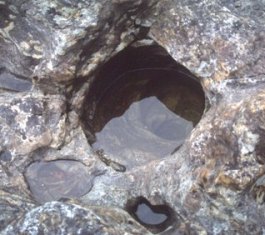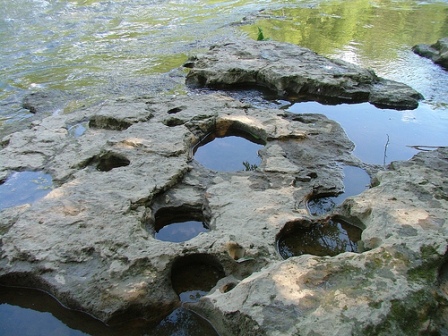
The Monashee Almanac is an online journal that shares history, mysteries and stories about early British Columbia and in particular the Monashee, Okanagan and Shuswap.
Celebrating History, Mysteries & Stories

Coyote lived in a lovely but lonely place far away from everyone, where he had no one with whom to speak or play or feast. At last he became very lonesome and made up his mind ever afterwards to break the monotony and invite all his friends once a year to a great feast and jollification.
So he set himself to work and built a great rapid and gave it the name Shuswap Falls. Then he made a big kettle out of stone with legs under it and hung it over the falls. Over this he constructed a fish trap, also out of stone, where he could catch many salmon and boil them in the Big Kettle. Then Coyote made a seat for himself out of stone, where he could watch the fish being caught and being cooked, and also where he could talk with his old cronies and at the same time see the sports and watch the feasting.
When he got all this finished to his satisfaction, the buds on the fir trees were just bursting out. By this sign he knew the salmon run was due. So he called aloud for his friends to come and feast. His voice could be heard from near and far, as it can even to this day; so it sounded long, long ago on every hill, in every vale, and all Coyote’s friends said, “Hark! There is a Coyote calling. Let us go.”
Coyote could distinguish who was coming as his friends called out to him on their way, accepting his invitation. He was overjoyed running round and round to catch his tail, as he heard the bawl of the Grizzly, the howl of the Timber wolf, the snort of the Elk, the Hoot of the Horned Owl, the chatter of the Kingfisher and all the other voices he knew.
Soon they were all assembled and great was the astonishment and rejoicing when they beheld the wonder of Coyote had wrought and the provisions he had made for their entertainment. It was a busy time, what with the feasting and the sports which lasted a fortnight with campfires burning brightly by day and by night, until all were dead tired, and the time came to depart. Then all shook old Coyote by the hand with grateful hearts for his hospitality. They all promised to come again when next the fir trees were busting out into bud. So all went home happy.
Now all of this happened a very, very long time ago. And to this day, when the firs are in bud each spring, the hills around Shuswap Falls still echo the invitation call of Coyote and the answering call of Coyote’s friends, and the campfire lights reappear.
Wise people say this is only fancy, but we know better.
Such is the Legend of Shuswap Falls as narrated by seniors of the Okanagan People, and translated from the Okanagan dialect by Mrs. William Brent for the Okanagan Historical Society 12th Report in 1948. This story is reprinted from how it appeared in the Okanagan Historical Society Report in 1948.
The Legend of Shuswap Falls
Old Coyote Makes a Great Kettle
A legend
in the Monashee landscape...
A long, long, time ago, when the world was young and fresh, before hatred, greed and strife entered, and all was peace and happiness, and all the animals lived harmoniously together, the Bear, Elk, fox, Coyote and all animals were ancestors of human beings.

Rare Phenomenon at Shuswap Falls
The hardness of the pebbles must be the same or higher than the rock at the bottom of stream where the kettle or pothole is forming. Where diamonds and quartz pebbles occur in the geology these hard substances can be found trapped at the bottom of potholes that they have carved. That is why these potholes are a good place to find diamonds (the hardest natural mineral on Earth).
The pot-holes at Shuswap Falls are situated in the bottom of the gorge, just below the new bridge, and are visible at low water, however they are being covered by layers of sand and silt carried by the river and deposited in the reservoir backed up by the hydro dam.
Early accounts describe four large potholes, four to six feet in diameter whose depths were difficult to determine since these early observations noted that they were almost entirely filled with sand. One had a communication cut through to the river, as its water was constantly moving. There was a log floating in it that was four feet long. Beside these there are twelve more holes of smaller diameter.
In the spillway channel a few potholes can be seen during low water flows and are present on the side of the canyon. These holes having been cut at a time when the river occupied a higher channel, before the gorge was cut. These sections are about 20 feet deep.
The illustrations of pot-holes in geological text books are usually about two feet in diameter, so the ones found at Shuswap Falls are considered singularly large. Besides it is also unusual for so many to be in one place. Thus at Shuswap Falls these pot-holes are phenomena worth more than a passing notice, however they continue to disappear from the landscape under layers of sand.
The Kettle Shapes
of Shuswap Falls
The rare phenomenon of river potholes
A rare phenomenon exists at Shuswap Falls so mysterious that geologists remain puzzled to this day. Pot-holes are rather rare geographical features found in hard-rock riverbeds.
Known to geologists as a Giant's Kettle, Giant's Cauldron or Pothole these cavities or holes appear to have been drilled in the surrounding rocks by eddying currents of water bearing stones, gravel and other detrital matter. Potholes vary in size and they most commonly occur in shields like the Canadian Shield, where there are ancient rocks (granite, gneiss) with different resistances to erosion. Small pebbles from these ancient rocks can be very hard and can fall into small cavities in stream bottoms and swirl, making the cavities wider and deeper.


Potholes similar to the ones pictured here lay beneath the sand in hydro reservoir at Shuswap Falls.. A few can still be seen in the canyon at low water.
